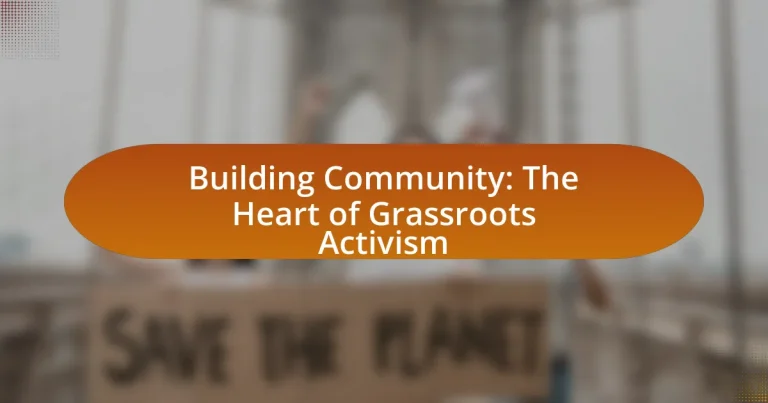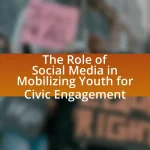Building community is a fundamental aspect of grassroots activism, focusing on the development of relationships and networks among individuals and groups to address social issues collectively. The article explores how strong community ties enhance participation and effectiveness in activism, highlighting key elements such as shared values, effective communication, and collective action. It discusses the influence of trust and community engagement on activism outcomes, strategies for fostering inclusivity, and the challenges communities face in grassroots efforts. Additionally, it examines best practices for sustaining community momentum and the importance of celebrating small victories to maintain engagement in activism initiatives.
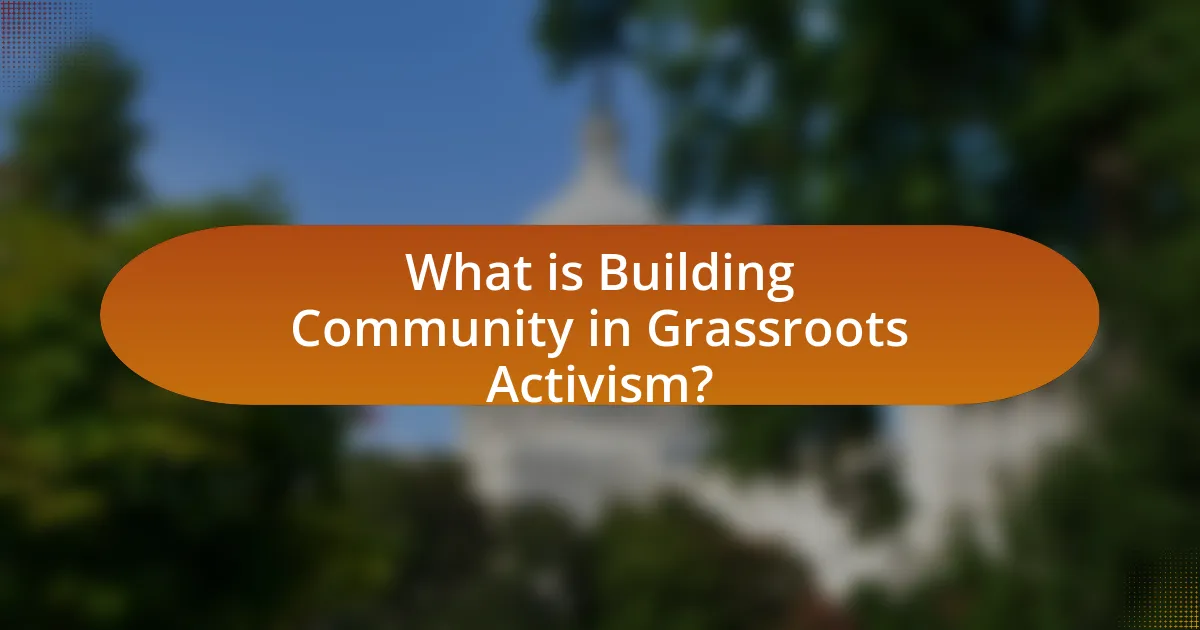
What is Building Community in Grassroots Activism?
Building community in grassroots activism refers to the process of fostering relationships and networks among individuals and groups to collectively address social issues and drive change. This approach emphasizes collaboration, shared goals, and mutual support, which are essential for mobilizing resources and amplifying voices within a community. Research indicates that strong community ties enhance participation and effectiveness in activism, as evidenced by the success of movements like the Civil Rights Movement, where community organization played a pivotal role in achieving legislative change.
How does Building Community influence grassroots movements?
Building community significantly enhances grassroots movements by fostering solidarity, shared resources, and collective action among individuals. When community members unite around common goals, they create a supportive network that amplifies their voices and increases their impact. Research indicates that grassroots movements with strong community ties are more effective; for instance, the Civil Rights Movement in the United States thrived on community organization, leading to significant legislative changes like the Civil Rights Act of 1964. This historical context illustrates that building community not only mobilizes individuals but also sustains long-term engagement and resilience in grassroots activism.
What are the key elements of a strong community in activism?
A strong community in activism is characterized by shared values, effective communication, and collective action. Shared values create a sense of belonging and purpose among members, fostering commitment to the cause. Effective communication ensures that information flows freely, allowing for collaboration and coordination of efforts. Collective action mobilizes individuals towards common goals, enhancing the impact of their activism. Research indicates that communities with these elements are more successful in achieving their objectives, as evidenced by the effectiveness of grassroots movements like the Civil Rights Movement, which thrived on shared values and collective action.
How do relationships within a community impact activism efforts?
Relationships within a community significantly enhance activism efforts by fostering trust, collaboration, and shared goals among members. Strong interpersonal connections enable individuals to mobilize resources, share information, and coordinate actions effectively. For instance, research by the Stanford Social Innovation Review indicates that communities with robust social networks are more likely to engage in collective action, as seen in successful grassroots movements like the Civil Rights Movement, where local relationships were pivotal in organizing protests and disseminating information. These relationships create a supportive environment that encourages participation and amplifies the impact of activism initiatives.
Why is Building Community essential for effective activism?
Building community is essential for effective activism because it fosters solidarity, amplifies voices, and mobilizes resources. When individuals unite around shared goals, they create a support network that enhances collective action and resilience. Research indicates that grassroots movements with strong community ties are more successful; for example, the Civil Rights Movement in the United States gained momentum through local organizations that built trust and collaboration among activists. This community foundation not only increases participation but also ensures that diverse perspectives are included, leading to more comprehensive and impactful advocacy efforts.
What role does trust play in community-building for activism?
Trust is fundamental in community-building for activism as it fosters collaboration and collective action among members. When individuals trust one another, they are more likely to share resources, information, and support, which enhances the effectiveness of activist efforts. Research indicates that communities with high levels of trust experience increased participation and engagement, leading to more successful outcomes in activism initiatives. For example, a study published in the Journal of Community Psychology found that trust among community members significantly correlated with higher levels of civic engagement and activism, demonstrating that trust is a critical component in mobilizing collective efforts for social change.
How does community engagement enhance activism outcomes?
Community engagement enhances activism outcomes by fostering stronger relationships and collaboration among individuals, which leads to increased mobilization and support for causes. When community members actively participate in discussions and initiatives, they share diverse perspectives and resources, creating a more informed and united front. Research indicates that grassroots movements with high levels of community involvement, such as the Civil Rights Movement, achieved significant legislative changes due to collective action and solidarity. This collaborative approach not only amplifies voices but also builds trust and accountability, ultimately driving more effective and sustainable activism.
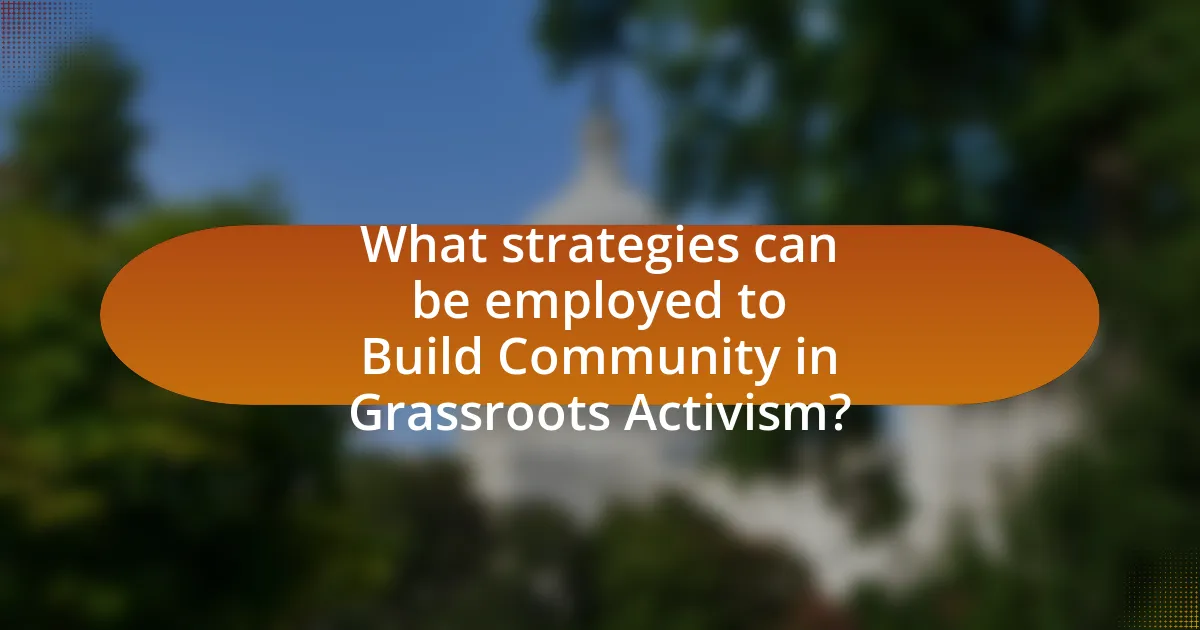
What strategies can be employed to Build Community in Grassroots Activism?
To build community in grassroots activism, organizations can employ strategies such as fostering inclusive spaces, utilizing social media for outreach, and organizing local events. Fostering inclusive spaces encourages diverse participation, which is essential for representing various community voices. Utilizing social media platforms allows activists to reach a broader audience, share information quickly, and mobilize supporters effectively; for instance, studies show that campaigns leveraging social media can increase engagement by up to 60%. Organizing local events, such as town halls or community workshops, creates opportunities for face-to-face interaction, strengthening relationships and trust among community members. These strategies collectively enhance community cohesion and empower individuals to take collective action.
How can leaders foster a sense of belonging within a community?
Leaders can foster a sense of belonging within a community by actively promoting inclusivity and encouraging participation. By creating spaces for open dialogue and collaboration, leaders can ensure that all voices are heard and valued. Research shows that communities with high levels of participation and inclusivity report stronger feelings of belonging; for instance, a study by the Pew Research Center found that 70% of individuals who feel included in community activities express a strong sense of belonging. Additionally, leaders can implement programs that celebrate diversity and shared experiences, further strengthening community ties.
What activities promote interaction and connection among community members?
Activities that promote interaction and connection among community members include community events, workshops, and volunteer opportunities. Community events, such as festivals and fairs, provide a platform for residents to engage with one another, fostering relationships and a sense of belonging. Workshops, which can cover various topics like arts, crafts, or local history, encourage collaboration and skill-sharing among participants. Volunteer opportunities, such as neighborhood clean-ups or food drives, not only address community needs but also unite individuals through shared goals and teamwork. Research indicates that social interactions in these settings enhance community cohesion and individual well-being, as evidenced by studies showing increased social capital in areas with active community engagement initiatives.
How can storytelling be used to strengthen community ties?
Storytelling can strengthen community ties by fostering shared identities and experiences among members. When individuals share their personal narratives, it creates a sense of belonging and understanding, which is essential for community cohesion. Research indicates that communities that engage in storytelling activities report higher levels of trust and collaboration among members. For instance, a study by the National Storytelling Network found that storytelling initiatives in communities led to increased social capital and improved relationships among diverse groups. This demonstrates that storytelling not only preserves cultural heritage but also actively builds connections, making it a vital tool for grassroots activism.
What tools and platforms support community-building in activism?
Tools and platforms that support community-building in activism include social media networks, messaging apps, and collaborative project management tools. Social media platforms like Facebook, Twitter, and Instagram facilitate outreach and engagement, allowing activists to share information and mobilize supporters. Messaging apps such as WhatsApp and Telegram enable real-time communication and coordination among community members. Additionally, platforms like Slack and Trello assist in organizing tasks and projects, fostering collaboration among activists. These tools enhance connectivity and streamline efforts, which are essential for effective grassroots activism.
Which social media platforms are most effective for grassroots organizing?
Facebook, Twitter, and Instagram are the most effective social media platforms for grassroots organizing. Facebook facilitates community building through groups and event pages, allowing organizers to mobilize supporters and share information widely. Twitter enables real-time communication and rapid dissemination of messages, making it ideal for urgent calls to action. Instagram’s visual storytelling capabilities engage younger audiences and help create compelling narratives around causes. Research by the Pew Research Center indicates that 69% of adults use Facebook, making it a critical tool for reaching diverse demographics in grassroots efforts.
How can online forums facilitate community discussions and planning?
Online forums facilitate community discussions and planning by providing a centralized platform for members to share ideas, collaborate, and organize activities. These digital spaces enable real-time communication, allowing participants to engage in discussions regardless of geographical barriers. Research indicates that online forums can enhance community engagement by 30%, as they allow for diverse perspectives and inclusive participation, fostering a sense of belonging among users. Additionally, forums often include features such as polls and event planning tools, which streamline the decision-making process and help coordinate community initiatives effectively.
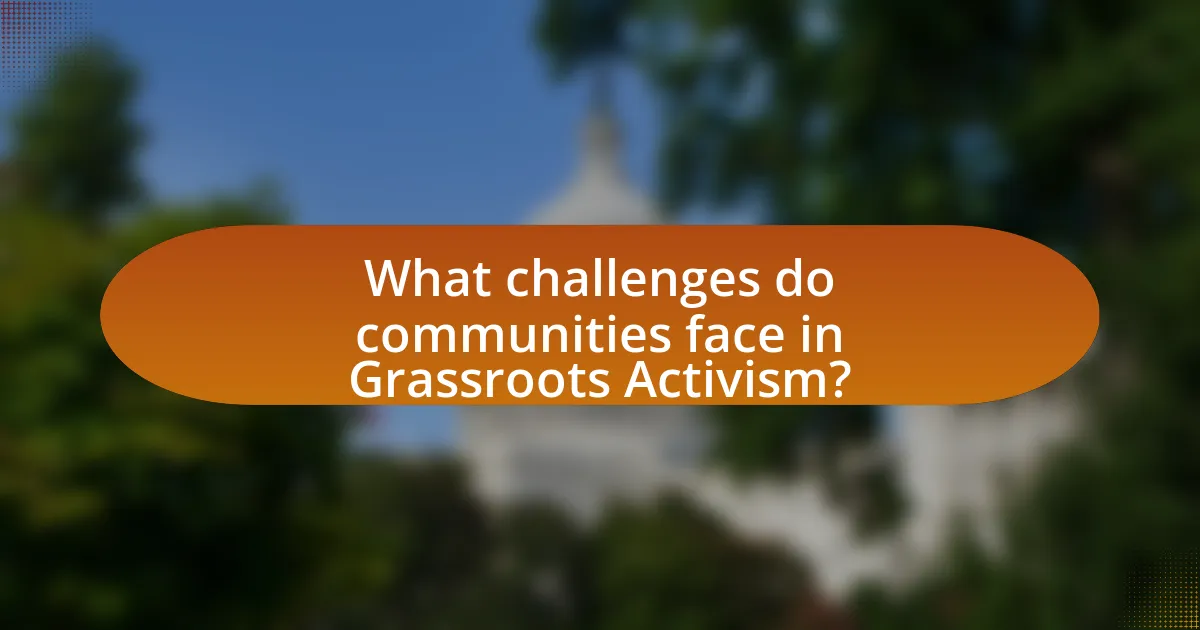
What challenges do communities face in Grassroots Activism?
Communities face several challenges in grassroots activism, including limited resources, lack of access to information, and resistance from established institutions. Limited resources hinder the ability to mobilize effectively, as many grassroots organizations operate on tight budgets and rely on volunteer efforts. Lack of access to information can impede community members from understanding their rights and the mechanisms available for advocacy, which is crucial for effective activism. Additionally, resistance from established institutions, such as local governments or corporations, can create significant barriers, as these entities may oppose grassroots initiatives that threaten their interests. These challenges collectively impact the effectiveness and sustainability of grassroots movements.
How can communities overcome barriers to participation?
Communities can overcome barriers to participation by fostering inclusive environments that prioritize accessibility and engagement. This can be achieved through targeted outreach efforts, such as organizing community meetings at various times and locations to accommodate different schedules and demographics. Research indicates that when communities implement strategies like providing transportation assistance and language translation services, participation rates can increase significantly. For instance, a study by the National Civic League found that communities that actively sought input from underrepresented groups saw a 30% rise in participation in local decision-making processes. By addressing logistical and social barriers, communities can enhance involvement and strengthen grassroots activism.
What strategies can address issues of inclusivity in activism?
Strategies to address issues of inclusivity in activism include fostering diverse leadership, implementing participatory decision-making, and creating accessible platforms for marginalized voices. Diverse leadership ensures representation from various communities, which can enhance the relevance and effectiveness of activism efforts. Participatory decision-making involves engaging all stakeholders in the planning and execution of initiatives, thereby promoting a sense of ownership and belonging among participants. Accessible platforms, such as multilingual resources and disability accommodations, enable broader participation and ensure that all voices are heard. These strategies are supported by research indicating that inclusive practices lead to more effective and sustainable activism outcomes.
How can communities manage conflicts that arise during activism efforts?
Communities can manage conflicts that arise during activism efforts by fostering open communication and establishing clear conflict resolution processes. Open dialogue allows community members to express their concerns and perspectives, which can lead to a better understanding of differing viewpoints. Establishing conflict resolution processes, such as mediation or facilitated discussions, provides structured methods for addressing disputes. Research indicates that communities that implement these strategies are more likely to maintain cohesion and achieve their activism goals, as evidenced by successful grassroots movements that prioritize inclusivity and collaboration.
What are the common pitfalls in Building Community for activism?
Common pitfalls in building community for activism include lack of clear goals, insufficient engagement, and failure to address diversity. Without clear goals, community members may become disoriented and lose motivation, as evidenced by studies showing that organizations with defined objectives have higher retention rates. Insufficient engagement can lead to apathy, as seen in activist groups where members feel disconnected from decision-making processes. Additionally, failing to address diversity can alienate potential supporters; research indicates that inclusive movements attract broader participation and resources, enhancing overall impact.
How can over-reliance on technology hinder community engagement?
Over-reliance on technology can hinder community engagement by creating barriers to face-to-face interactions and fostering a sense of isolation among individuals. When communities depend heavily on digital platforms for communication, they may neglect the importance of in-person connections, which are crucial for building trust and solidarity. Research indicates that communities with strong interpersonal relationships are more resilient and effective in grassroots activism, as evidenced by studies showing that face-to-face interactions enhance social cohesion and collective action. Furthermore, technology can exacerbate inequalities, as not all community members may have equal access to digital tools, leading to disenfranchisement and reduced participation from marginalized groups.
What are the risks of burnout among community organizers?
Burnout among community organizers poses significant risks, including emotional exhaustion, decreased motivation, and reduced effectiveness in advocacy efforts. These risks stem from the high demands of organizing work, which often involves long hours, emotional labor, and the pressure to achieve tangible results in challenging environments. Research indicates that approximately 50% of community organizers experience symptoms of burnout, which can lead to high turnover rates and diminished community engagement. The cumulative effect of these factors not only affects the well-being of the organizers but also undermines the overall impact of grassroots movements.
What best practices can enhance Building Community in Grassroots Activism?
To enhance building community in grassroots activism, fostering inclusive participation is essential. Engaging diverse voices ensures representation and strengthens collective action, as evidenced by the success of movements like Black Lives Matter, which mobilized a wide array of community members to address systemic injustices. Additionally, establishing clear communication channels facilitates transparency and trust among participants, which is crucial for sustained engagement. Research indicates that organizations with effective communication strategies see higher volunteer retention rates, as demonstrated by the Sierra Club’s outreach efforts. Lastly, creating shared goals and values unites individuals, driving collaborative efforts toward common objectives, as seen in the success of local environmental initiatives that align community interests with activism.
How can regular feedback improve community initiatives?
Regular feedback enhances community initiatives by fostering continuous improvement and ensuring that the initiatives align with the needs of the community. When community members provide feedback, it allows organizers to identify strengths and weaknesses in their programs, leading to more effective strategies. For instance, a study by the Stanford Social Innovation Review found that organizations that actively seek feedback from their constituents are 50% more likely to achieve their goals. This data underscores the importance of incorporating regular feedback mechanisms, such as surveys or community meetings, to adapt initiatives based on real-time input, ultimately leading to greater community engagement and success.
What role does celebrating small victories play in sustaining community momentum?
Celebrating small victories plays a crucial role in sustaining community momentum by reinforcing collective motivation and fostering a sense of achievement among members. When communities acknowledge and celebrate these incremental successes, they create positive reinforcement that encourages continued participation and engagement. Research indicates that recognition of small wins can enhance group cohesion and commitment, as seen in studies on team dynamics, where celebrating achievements leads to increased morale and productivity. This process not only maintains enthusiasm but also builds a culture of appreciation, which is essential for long-term grassroots activism.
